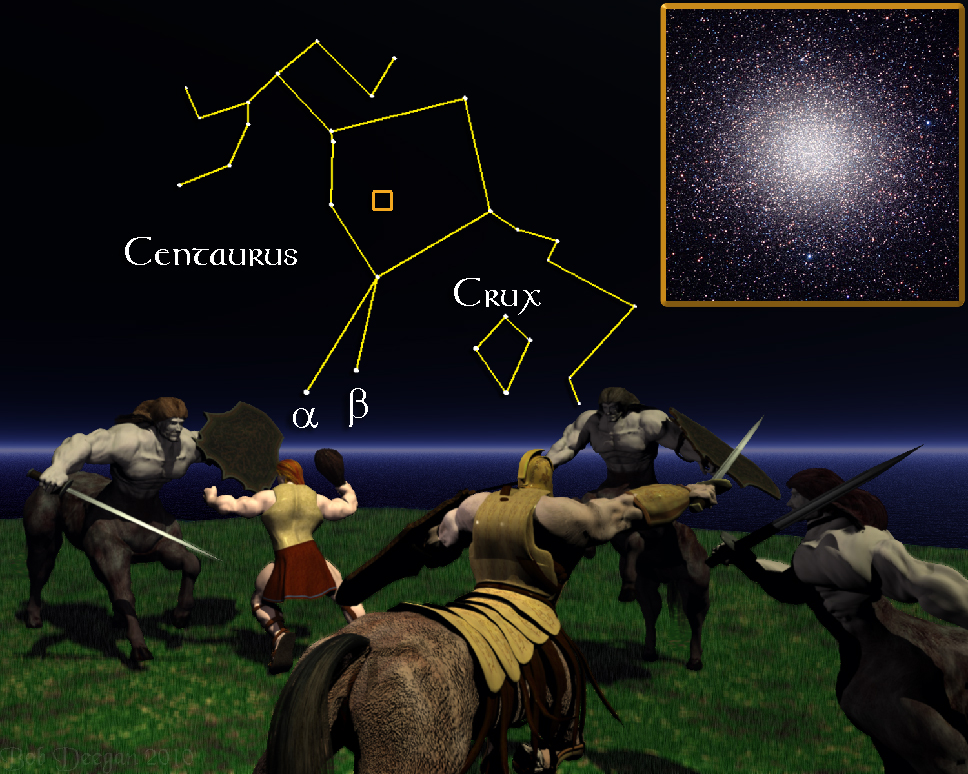
For the week including February 26, 2010

THE CENTAUR
About 5,000 years ago, an observer in our region who looked south could see two brilliant stars close to the horizon oriented toward a luminous diamond of stars. This beautiful arrangement, the stars Alpha and Beta Centauri pointing the way to Crux, the Southern Cross, is gone from our skies. Precession, a slow wobble of the Earth’s axis, which takes some 27,000 years to complete, has caused these stars to dip too far below the southern horizon for us to see them. Nowadays, Hawaii gets a better look at them than the rest of the USA. Still, if you live in Texas or Florida and have a good view of the south, you can find the Southern Cross if you’re willing to lose a little sleep. Around three o’clock in the morning, a quick look to the southern horizon will be enough to spot these wonderful stars.
The celestial Centaur comes to us from the Twelve Labors of Hercules in Greek mythology. Each of the twelve labors was thought to be an impossible task and was most often life threatening as well. The fourth of these labors was to capture the Erymanthian Boar, a powerful creature of unfriendly disposition that liked to hunt and eat local residents. On his way to the monster’s mountainous lair, Hercules decided to stop and visit an old friend, Pholus. Pholus, a centaur who was famous for his kindness and hospitality, laid out a large banquet and offered Hercules as much as he could eat or drink. He asked Hercules only to leave a certain cask of wine untouched. Of course, after a lot of wine, Hercules had a great deal of trouble telling one cask from another and so it was that he mistakenly uncorked the fabled Wine of the Centaurs. This vintage, meant only for centaurs, had such a strong bouquet that its scent was discernable for miles. Soon, every centaur in the vicinity descended on the home of Pholus to join the party they thought was in progress. When they saw Hercules drinking their special wine, the centaurs became enraged and a fierce battle erupted. Pholus defended his guest and together they drove off the other centaurs. Unfortunately, Pholus did not survive the combat. At Hercules’ request, the gods placed his honored host among the stars.
The triple-star system Alpha Centauri is the closest to our Sun, only four light years away. Because it’s so close, the otherwise average Alpha Centauri shines enough to be ranked third brightest in our night sky. Alpha Centauri was given the name “Rigel Kentaurus” on old star maps, Arabic for the “Leg of the Centaur”. Just to the right of it is Beta Centauri, “Hadar”. Hadar is the eleventh brightest star in the sky and makes a brilliant pairing with Alpha Centauri. For centuries, navigators have instantly oriented themselves by these stars because nowhere else in the sky are two bright stars so close together.
Close to 10 million stars comprise the globular cluster known as Omega Centauri. At an estimated distance of 18,000 light years, this cluster is visible to the naked eye as a hazy patch of light, large as the full Moon. Shown in the photograph by Loke Kun Tan, at upper right in our illustration, Omega Centauri is about 150 light years across and orbits around the outside of our galaxy once every hundred million years.Unless otherwise indicated, all content of this web site is the copyright of Robert Deegan and all rights are reserved.
For more information, or to comment, please contact: Bob@NightSkies.org